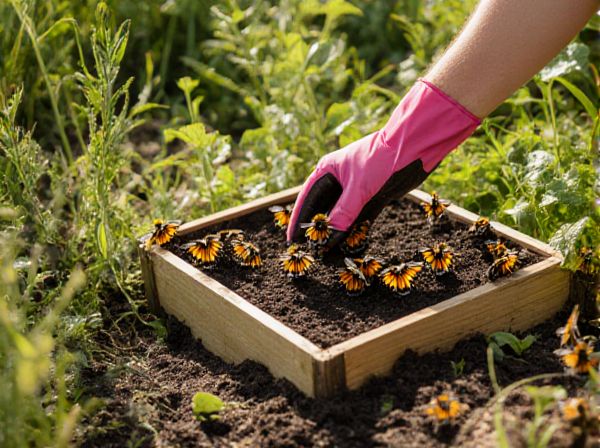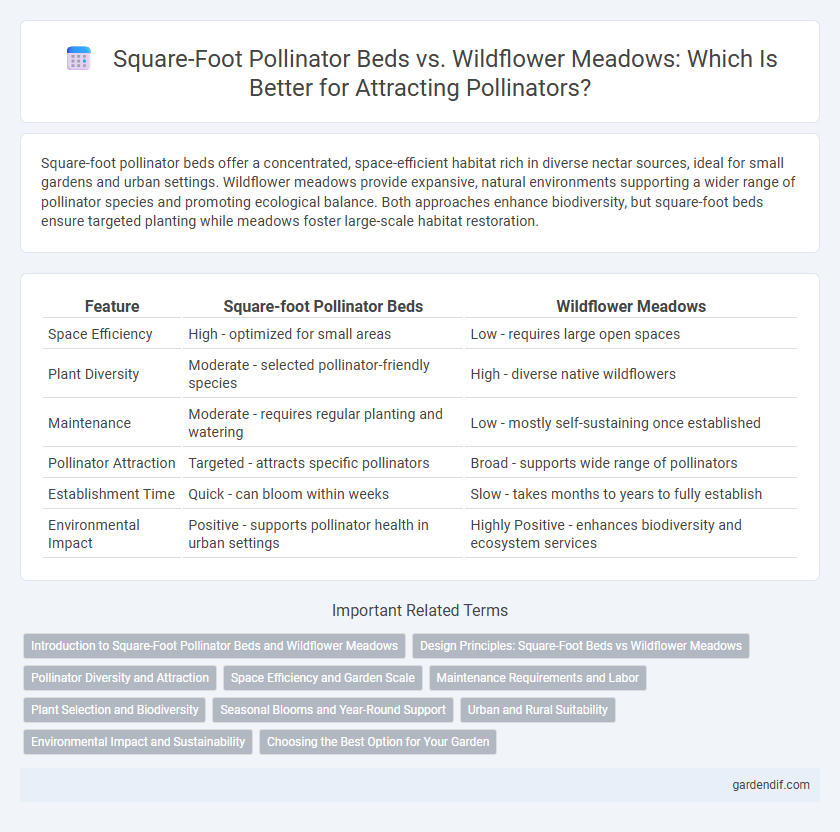
Square-foot Pollinator Beds vs Wildflower Meadows Illustration
Square-foot pollinator beds offer a concentrated, space-efficient habitat rich in diverse nectar sources, ideal for small gardens and urban settings. Wildflower meadows provide expansive, natural environments supporting a wider range of pollinator species and promoting ecological balance. Both approaches enhance biodiversity, but square-foot beds ensure targeted planting while meadows foster large-scale habitat restoration.
Table of Comparison
| Feature | Square-foot Pollinator Beds | Wildflower Meadows |
|---|---|---|
| Space Efficiency | High - optimized for small areas | Low - requires large open spaces |
| Plant Diversity | Moderate - selected pollinator-friendly species | High - diverse native wildflowers |
| Maintenance | Moderate - requires regular planting and watering | Low - mostly self-sustaining once established |
| Pollinator Attraction | Targeted - attracts specific pollinators | Broad - supports wide range of pollinators |
| Establishment Time | Quick - can bloom within weeks | Slow - takes months to years to fully establish |
| Environmental Impact | Positive - supports pollinator health in urban settings | Highly Positive - enhances biodiversity and ecosystem services |
Introduction to Square-Foot Pollinator Beds and Wildflower Meadows
Square-foot pollinator beds offer a compact, intensive planting strategy designed to maximize floral diversity and support pollinator species in small urban or suburban spaces. Wildflower meadows provide extensive, naturalized habitats that promote biodiversity and sustain a wide range of pollinators over larger areas. Both methods contribute to pollinator conservation, with square-foot beds emphasizing high-density planting and wildflower meadows fostering ecosystem complexity.
Design Principles: Square-Foot Beds vs Wildflower Meadows
Square-foot pollinator beds maximize plant diversity in compact spaces by using precise planting grids to optimize floral density and bloom sequencing, enhancing year-round pollinator attraction. Wildflower meadows emphasize ecological balance through naturalistic planting, allowing self-sustaining propagation and diverse habitat structures that support a wider range of pollinator species. Design principles for square-foot beds prioritize intensive management and spatial efficiency, while wildflower meadows focus on ecosystem resilience and minimal intervention.
Pollinator Diversity and Attraction
Square-foot pollinator beds maximize pollinator diversity by concentrating a variety of flowering plants in a compact space, ensuring continuous blooms that attract bees, butterflies, and hoverflies throughout the seasons. Wildflower meadows offer a larger, more natural habitat supporting a broader range of pollinators, including ground-nesting bees and specialized insects drawn to native flora. Both approaches enhance pollinator attraction but differ in spatial scale and species composition, with square-foot beds providing targeted floral resources and meadows promoting ecosystem-wide biodiversity.
Space Efficiency and Garden Scale
Square-foot pollinator beds maximize space efficiency by concentrating diverse nectar and pollen sources within small, manageable plots, ideal for urban or limited garden areas. In contrast, wildflower meadows require larger, open spaces to thrive but support greater biodiversity and sustain more pollinator species across broader seasonal periods. Choosing between these depends on garden scale: compact gardens benefit from dense, square-foot beds, while expansive landscapes favor the ecological richness of wildflower meadows.
Maintenance Requirements and Labor
Square-foot pollinator beds require intensive maintenance, including precise planting, regular watering, and frequent weeding to ensure optimal flower density for pollinator attraction. Wildflower meadows demand less labor, thriving with minimal intervention aside from occasional mowing and invasive species control, promoting natural growth cycles. The higher initial labor investment in square-foot beds contrasts with the sustainable, low-maintenance nature of wildflower meadows, influencing long-term upkeep strategies for pollinator-friendly habitats.
Plant Selection and Biodiversity
Square-foot pollinator beds concentrate on dense planting of select native species optimized for rapid bloom and targeted pollinator attraction, promoting high flower diversity within limited space. Wildflower meadows support greater overall biodiversity by incorporating a wide variety of grasses and forbs, creating complex habitats that sustain diverse pollinator communities over extended seasons. Strategic plant selection in square-foot beds prioritizes nectar and pollen-rich species to maximize pollinator visitation, whereas wildflower meadows emphasize ecological balance and native ecosystem resilience.
Seasonal Blooms and Year-Round Support
Square-foot pollinator beds provide concentrated, strategically planted seasonal blooms that offer targeted nourishment during critical pollination periods. Wildflower meadows support diverse pollinator species with a natural succession of blooms that extend throughout the year, fostering continuous habitat and food supply. Both options enhance biodiversity, but combining square-foot beds with wildflower meadows maximizes floral resources and year-round pollinator support.
Urban and Rural Suitability
Square-foot pollinator beds offer a highly manageable option ideal for urban environments with limited space, providing concentrated floral resources that attract bees, butterflies, and other pollinators within compact areas. Wildflower meadows, better suited for rural settings, support greater biodiversity by offering extensive, diverse habitats that sustain varied pollinator species across larger landscapes. Both approaches enhance pollinator populations, but square-foot beds maximize efficiency in dense urban spaces while wildflower meadows promote wider ecological benefits in rural regions.
Environmental Impact and Sustainability
Square-foot pollinator beds maximize space efficiency, providing concentrated habitats that support diverse pollinator species in urban and small-scale environments. Wildflower meadows enhance biodiversity on a larger scale, promoting ecosystem resilience and improving soil health through natural plant succession. Both methods contribute significantly to environmental sustainability by increasing pollinator populations, which are crucial for crop pollination and maintaining ecological balance.
Choosing the Best Option for Your Garden
Square-foot pollinator beds maximize space efficiency by concentrating diverse nectar and pollen sources in a small area, attracting a variety of bees, butterflies, and hoverflies year-round. Wildflower meadows support greater biodiversity by providing extensive habitats and food resources for specialist pollinators and ground-nesting insects, enhancing ecosystem resilience. Gardeners should consider available space, maintenance capacity, and target pollinator species when choosing between compact pollinator beds or expansive wildflower meadows.
Square-foot Pollinator Beds vs Wildflower Meadows Infographic

 gardendif.com
gardendif.com